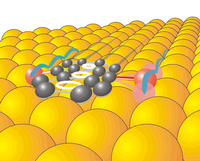
Credit: L. Bartels
Only last week we learned about a nanoscale car developed by researchers at Rice University. Today BoingBoing points us to this news release from the University of California at Riverside about a molecule that scientists there have developed that can move in a straight line in a manner that mimics human walking. The research team, led by Ludwig Bartels, believe this discovery will help clear a significant hurdle towards the development of molecular memory that could be 1000 times more compact than that found in current storage devices.
The walker molecule is 9,10-dithioanthracene, abbreviated DTA. It has two linkers that serve as “feet.” As the surface the molecule rests on is heated, one linker will lift up and take a step while the other foot acts as guide keeping the molecule on straight path. As the linkers alternatively take steps the molecule moves in a straight path. This is a significant advancement because previously in order to move a molecule in a straight line a groove or rail was needed for guidance.
In the 1990’s IBM had proposed a “molecular abacus” as a way to store data. In short, the position of molecules on a “molecular bar” would determine the number that was stored. They were not able to develop that guide bar and eventually gave up on the concept. This new walker molecule eliminates the need for a bar as means to move molecules back in forth in a straight line and could breath new life into the project.
Read the full news release at UCR.edu: “Molecule Walks Like a Human“
